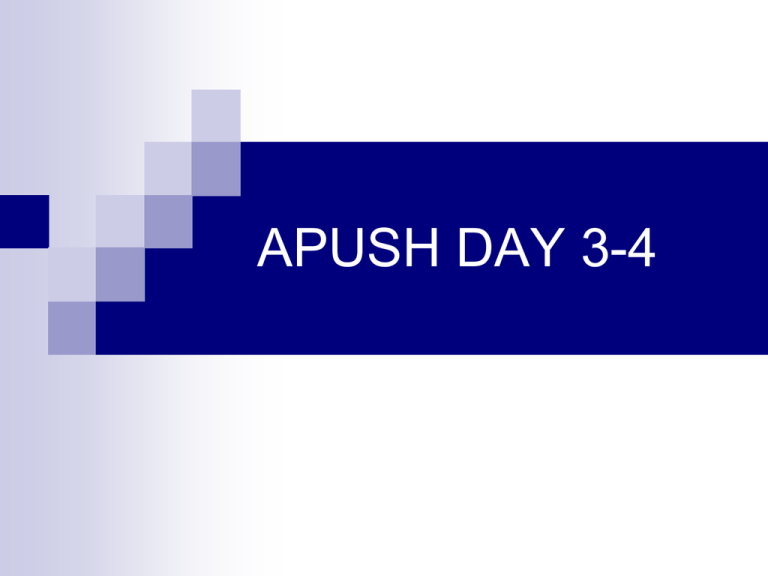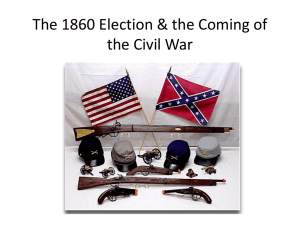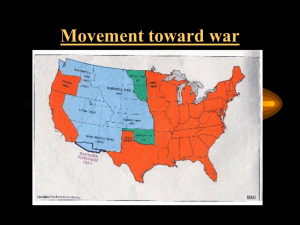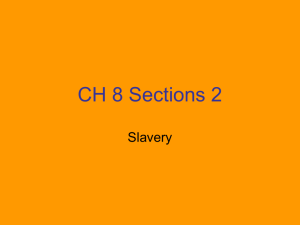APUSH DAY 4 - My Teacher Pages
advertisement

APUSH DAY 3-4 The Birth of Texas Stephen Austin Santa Anna Sam Houston Jackson’s dilemma Election of 1836 Birth of the Whigs “King Andrew I” William Henry Harrison Martin Van Buren Jackson’s Legacy Van Buren’s Presidency Caroline Incident “Aroostook War” Creole Incident Panic of 1837 Causes Results Whigs Proposals shot down by Van Buren Treasury Bill of 1840 (Divorce Bill) Independent Treasury System Election of 1840 Van Buren Re-nominated by Democrats “Log Cabin and Hard Cider” William Henry Harrison Whig – John Tyler Secretary of State: Daniel Webster Election of 1840 VP Anti-Jackson Democrat Secretary of State: Daniel Webster Tyler vs. Congress Webster-Ashburton Treaty (1842) Clay’s Bill for 3rd BUS Canadian Border 45th Parallell The Rise of "King Cotton" Prior to 1793, the Southern economy was weak Eli Whitney’s Cotton Gin (1793) Trade Cotton exported to England; $ from sale of cotton used to buy northern goods For a time, prosperity of both North and South rested on slave labor Cotton accounted for 50% of all American exports after 1840. The Three South's: Border South: Delaware, Maryland, Kentucky, & Missouri Plantations scarcer; cotton cultivation almost nonexistent; Tobacco main slave crop (as in Middle South); More grain production (as in Middle South) 1850, Slaves = 17% of population.; Avg. 5 slaves per slaveholder 1850, over 21% of Border South’s blacks free; 46% of South’s free blacks 22% of white families owned slaves Of all who owned more than 20 slaves in South: 6%; Ultra-wealthy = 1% Produced over 50% of South’s industrial products The Three South's: Middle South: Virginia, North Carolina, Tennessee, and Arkansas. Each state had one section resembling more the Border South and another resembling the Lower South. Unionists would prevail after Lincoln elected; Disunionists would prevail after war began Many plantations in eastern Virginia and western Tennessee 1850, slaves = 30% of population; Avg. 8 slaves per slaveholder 36% of white families owned slaves Of all who owned more than 20 slaves in South: 32%; Ultra-wealthy = 14% The Three South’s: Lower South: South Carolina, Florida, Georgia, Alabama, Mississippi, Louisiana, Texas Plantations prevalent; cotton was king; grew 95% of Dixie’s cotton & almost all of its sugar, rice, and indigo Disunionists (secessionists) would prevail after Lincoln was elected 1850, slaves = 47% of population; Avg. 12 slaves per slaveholder Less than 2% of blacks free; only 15% of South’s free blacks 43% of white families owned slaves Of all who owned more than 20 slaves in South: 62%; Ultra-wealthy = 85% Produced less than 20% of South’s industrial products Slaves and the slave system (the "Peculiar Institution") Economic structure of South was monopolistic, dominated by wealthy plantation owners Plantation system Risky : Slaves might die of disease, injure themselves, or run away. One-crop economy Repelled large-scale European immigration Slaves and the slave system (the "Peculiar Institution") Plantation slavery Nearly 4 million slaves by 1860; quadrupled in number since 1800 Slaves seen as valuable assets and primary source of wealth Punishment often brutal to send a message to other slaves not to defy master’s authority Life in the newly emerging western areas particularly harsh (LA, TX, MS, AL) Afro-American slave culture developed Slaves and the slave system (the "Peculiar Institution") Burdens of slavery Slaves deprived of dignity and sense of responsibility that free people have, suffered cruel physical and psychological treatment, and were ultimately convinced that they were inferior and deserved their lot in life. Denied an education since; seen as dangerous to give slaves ideas of freedom Slaves often insidiously sabotaged their master’s system Many attempted to escape Slaves and the slave system (the "Peculiar Institution") Slave Revolts - Stono Rebellion, 1739 - Gabriel Prosser, 1800 - Denmark Vesey, a mulatto in Charleston, devised the largest revolt ever in 1822. - Nat Turner’s revolt -- 1831 Southern white paranoia The White Majority By 1860, only 1/4 of white southerners owned slaves or belonged to slaveowning families 75% of white southerners owned no slaves at all. Mountain whites Free Blacks Numbered about 250,000 in the South by 1860 Discrimination in the South Discrimination in the North Early Abolitionism Definition: Abolitionism: Movement in the North that demanded the immediate end of slavery First abolitionist movements began around the time of the Revolution esp. Quakers American colonization Society Early Abolitionism Abolitionists in the 1830s Second Great Awakening convinced abolitionists of the sin of slavery. Abolitionists inspired that Britain emancipated their slaves in the West Indies in 1833 Radical Abolitionism William Lloyd Garrison American Anti-Slavery Society Theodore Dwight Weld Wendell Phillips Angelina and Sarah Grimke Arthur and Lewis Tappan - wealthy New York silk merchants. *** Organization would eventually split along gender lines; women’s rights issues*** Radical Abolitionism David Walker Sojourner Truth Elijah Lovejoy Martin Delaney Frederick Douglass Pro-slavery whites responded by launching a massive defense of slavery as a positive good. • • • • • Slavery supported by the Bible (Genesis) and Aristotle (slavery existed in ancient Greece). It was good for barbarous Africans who were civilized and Christianized Master-slave relationships resembled those of a "family." George Fitzhugh -- most famous of pro-slavery apologists’ “Gag resolution" Abolitionist impact in the North Abolitionists, esp. Garrison, were unpopular in many parts of the North. Many mob outbursts in response to extreme abolitionists Ambitious politicians avoided abolitionists (e.g., Lincoln) – abolitionism was political suicide By 1850, abolitionism had had a deep effect on the Northern psyche. Popular Sovereignty and the Mexican Cession Intense debate over what to do with the Mexican Cession. Wilmot Proviso: New territory should be free of slavery Issue threatened to split both Whigs and Democrats along sectional lines "Popular Sovereignty" Lewis Cass, 1812 War vet, became Democratic candidate for president in 1848 Definition: Sovereign people of a territory, under general principles of the Constitution, should determine themselves the status of slavery. Supported by many because it kept in line with democratic tradition of self-determination. Fatal flaw: It could spread the "peculiar institution" to new territories. Election of 1848 Whigs nominated Zachary Taylor, "Hero of Buena Vista" Free-Soil party Coalition of northern antislavery Whig, Democrat, and Liberty Party men in the North distrusting Cass & Taylor Result: Taylor 163, Cass 127, Van Buren 0 Free-Soilers won no states and did not actually affect the outcome of the election. California Statehood Gold discovered in 1848 at Sutter’s Mill; prospectors in 1848 known as "fortyeighters“ 1849 -- Masses of adventurers flocked to northern California. Gold essentially paved the way for rapid economic growth in California CA drafted a Constitution in 1849 that excluded slavery and asked Congress for admission Sectional Balance in 1850 South Yet, South deeply worried Had presidency, majority in the cabinet, and a majority in the Supreme Court Equal number of states in Senate thus strong veto power In 1850, 15 free and 15 slave states CA would tip the balance in the Senate and set a free-state precedent in the southwest New Mexico and Utah territories seemed leaning toward free state status. Texas claimed vast area east of Rio Grande (part of NM CO, KA & OK) and threatened to seize Santa Fe. Southerners angered by Northern demands for abolition of slavery in Wash. DC. Extremely angered over loss of runaway slaves, many assisted by North. When CA applied, southern "fire-eaters" threatened secession Underground Railroad and the Fugitive Slave issue Consisted of informal chain of antislavery homes which hundreds of slaves were aided by black & white abolitionists in their escape to free soil Canada. Harriet Tubman ("Moses") (ex-slave from Maryland who escaped to Canada) Jerry Loguen: Led hundreds of slaves to their freedom Prigg v. Pennsylvania, 1842 Political. significance: by 1850 southerners demanded a new more stringent fugitive-slave law Compromise of 1850 Sunset of the "Great Triumvirate" Clay initiated his 3rd great compromise Calhoun (dying of TB) rejected Clay’s position as not being adequate safeguards. Webster supported Clay’s compromise (famous "7th of March speech" of 1850) Meanwhile, William H. Seward (nicknamed "Higher Law" Seward by his adversaries) "Compromise of 1850" California admitted as a free state ‘ Abolition of the slave trade in District of Columbia Popular sovereignty in remainder of Mexican Cession: New Mexico and Utah territories. More stringent Fugitive Slave Law (than 1793) Texas to receive $10 million from federal gov’t as compensation for its surrendering of disputed territory to New Mexico. Result North got better deal. Fugitive Slave Law became the single most important frictional issue between north and south in the 1850s. Compromise of 1850 won the Civil War for the North Election of 1852 Democrats nominated Franklin Pierce (from NH) Whigs nominated General Winfield Scott ("Old Fuss & Feathers") but party fatally split Result: Pierce d. Scott 254 - 42 Significance: Marked effective end of Whig party; complete death 2 years later Significance of Whig party: Webster & Clay had kept idea of Union alive (both died in 1852) Expansionism under President Pierce War in Nicaragua seemed inevitable; Britain challenged Monroe Doctrine Clayton-Bulwer Treaty (1850): Neither U.S. or Britain would fortify or secure exclusive control over any future isthmian waterway. America looks toward Asia Expansionism under President Pierce Cuba Polk had offered Spain $100 million for Cuba; Spain categorically refused. 1850-51 -- two expeditions by private southern adventurers into Cuba failed. 1854, Spain seized U.S. steamer Black Warrior on a technicality. Ostend Manifesto Secret document whereby U.S. would offer $120 million for Cuba and if Spain U.S. would take it by force. News leaked out and angry northern free-soilers forced Pierce to abandon it. Gadsden Purchase (1853) U.S. concerned that CA & Oregon inaccessible by land & sea routes too tough Debate: Should transcontinental railroad route run through the North or South? Result South boosted its claim to railroad North now tried to quickly organize Nebraska territory but the South opposed it. The Kansas-Nebraska Act (1854) Stephen Douglas proposed carving Nebraska Territory into 2: Nebraska, Kansas Slavery issue would be based on popular sovereignty His main motive was to give Illinois the eastern terminus for the proposed Pacific railroad. Kansas would presumably become slave; Nebraska free 36-30 line prohibited slavery north of it; Kansas above it. Southerners fully supported it and pushed Pierce to support KS-NB Act Douglas successfully rammed the bill through Congress; great orator of his generation The Kansas-Nebraska Act (1854) Kansas-Nebraska Act passed in 1854 Northern reaction Southern reaction Effectively wrecked the Compromises of 1820 & 1850 Birth of the Republican party Republican party formed in response to the Kansas-Nebraska Act. Antislavery literature Harriet Beecher Stowe: Uncle Tom’s Cabin (1852) Hinton R. Helper: The Impending Crisis of the South (1857) "Bleeding Kansas" New England Emigrant Aid Company: Sent 2,000 into Kansas to prevent slavery from taking hold and to make a profit. Southerners infuriated by apparent northern betrayal -- attempts to abolitionize Kansas. 1855 election in Kansas for first territorial legislature 1856, a gang of proslavery raiders shot up and burned part of free-soil Lawrence, Kansas. The Caning of Charles Sumner Sumner a leading abolitionist Senator from Massachusetts, gave speech "Crime Against Kansas" where he lashed out at southern pro-slaveryites and insulted a S.C. Senator S.C. Congressman Preston Brooks retaliated by hitting Sumner over the head 30 times or more with an 11-oz gold-headed cane. The House of Reps could not find enough votes (122 to 95-- 2/3 needed) to expel Brooks but he resigned nonetheless, and was unanimously reelected by S.C. Sumner came to symbolize for the North the evils of the slavery system (along with bleeding Kansas issue) Pottawatomie Massacre -- John Brown & followers, in May 1856, hacked 5 men to pieces with broadswords in response to attack on Lawrence (and the caning of Sumner) Civil war in Kansas ensued from 1856 and merged with Civil War of 1861-1865 Lecompton Constitution (1857) Kansas had enough people to apply for statehood on popular sovereignty basis. Southerners, still in power since 1855, devised a tricky document People were not allowed to vote for or against constitution as a whole but voted for the constitution. with or w/o slavery. If people voted no on slavery, rights of slaveholders already in KS protected Infuriated free-soilers boycotted the polls Slaveryites approved constitution with slavery late in 1857. Election of 1856 James Buchanan chosen as Democratic nominee over Pierce (seen as too weak) and Douglas (who alienated the southern wing of the party after denouncing Lecompton constitution.) Republicans nominated Captain John C. Ferment "Pathfinder of the West" American Party ("know-nothing") Nativist in orientation Buchanan d. Fremont 174 to 114; Fillmore 8. The Dred Scott Decision (March 6, 1857) Dried Scott had lived with his master for 5 years in Illinois and Wisconsin Territory. 80-year-old Marylander Chief Justice Roger B. Taney wrote the 55 page opinion. Decision Impact Financial Crash of 1857 Not as bad as Panic of 1837 but probably the worst psychologically in 19th c. Causes Influx of California gold into economy inflated currency. Crimean War over stimulated growing of grain Speculation in land and railroads backfired. Results Over 5,000 businesses failed within a year. Unemployment widespread Renewed demand for free farms of 160 acres from public domain land. Demand for higher tariff rates Republicans had two major issues for 1860: higher tariffs & Homestead Act Lincoln-Douglas Debates (1858) – Senate seat in Illinois Lincoln’s nomination speech: "A house divided cannot stand. I believe this government cannot endure; permanently half slave and half free. Lincoln challenged Douglas to a series of seven joint debates Freeport debate most famous -Freeport Doctrine John Brown attacks Harper’s Ferry Brown’s scheme: invade the South secretly with a few followers and lead slaves to rise, give them arms, and establish a kind of black free state. October, 1859 -- Seized the arsenal at Harper’s Ferry Brown and his followers were hanged after a brief but legal trial. Brown became a martyr in the North Effects of Harper’s Ferry were ominous in southern eyes. Nominating Conventions of 1860 Democratic party split in two Met first in South Carolina with Douglas as leading candidate of northern wing Next convention in Baltimore nominated Douglas while the Democratic party split in two Southern Democratic Party nominated John C. Breckinridge: Constitutional Union Party nominated John Bell of Tennessee Republicans nominate Abraham Lincoln Seward the front-runner but perceived as too radical for victory in general election. Republican platform (broadly based) Southern secessionists warned that the election of Lincoln would split the Union. Presidential election of 1860 Lincoln elected president with only 40% of the vote; most sectional election in history. Lincoln won all Northern states except NJ and MO (180 electoral votes to 123) Breckinridge won all the Deep South states plus AK, MD, and DE Bell won Border States of VA KY and mid-slave state of TN Douglas won only MO and NJ but finished 2nd in popular votes South still had control of both Houses of Congress and a 5-4 majority on Supreme Court Southern states secede from the Union Four days after the election of Lincoln, the "Black Republican", South Carolina legislature unanimously called for a special convention in Charleston. Within six weeks, six other states seceded (MS, FL, AL, GA, LA, TX) all during Buchanan’s "lame-duck" period. December, 1860, 170 South Carolina unanimously voted to secede from the other states. Four others seceded in April, 1861, after beginning of Civil War (VA, AK, NC, TN) as they refused to fight their fellow southerners and agree to Lincoln’s call for volunteers. Confederate States of America formed in Montgomery Alabama meeting. Jefferson Davis chosen as president of provisional government to be located at Richmond, VA (after Fort Sumter) Southern states secede from the Union President Buchanan did little to prevent southern secession. Claimed the Constitution did not give him authority to stop secession with force. More significantly, northern army was small and weak and scattered on the frontier. Many of his advisors pro-southern Northern sentiment predominantly for peaceful reconciliation rather than war Ironically, Lincoln continued Buchanan’s vacillating policy when he became president. Buchanan’s serendipitous wait-and-see policy probably helped save the Union. Reasons for southern secession 1. 2. 3. 4. 5. 6. Alarmed at the political balance tipping in favor of the North Horrified at victory of the sectional Republican party which appeared to threaten their rights as a slaveholding minority. Angry over free-soil criticism and abolitionism, and northern interference such as the Underground Railroad and John Brown’s raid. Many southerners felt secession would be unopposed Opportunity to end generations of dependence to the North. Morally they were in the right Crittenden amendments -- final attempt at compromise Proposed by Senator John J. Crittenden of Kentucky (heir to political throne of Clay) Designed to appease the South Provisions Rejected by Lincoln; all hope of compromise was gone. Union War Strategy Initial attempts to strike decisive blows in Virginia failed miserably (Bull Run, Peninsula Campaign, Vicksburg, Chancellorsville) Later, developed into four phases: strategy geared more toward attrition. WAR IN THE EAST: 1861 Battle of Bull Run (Manassas) -- July 21, 1861 (30 southwest of Washington) WAR IN THE EAST: 1861 General George B. McClellan and the Army of the Potomac Lincoln gave McClellan command of the Army of the Potomac in late 1861. Fatal flaw: Overcautious; frequently believed he was outnumbered when in fact he always possessed numerical advantages; Lincoln accused him of having "the slows" The Union blockade -- "Anaconda Plan" Initially ineffective; 3,500 miles of coastline too daunting for undeveloped Union navy and undeveloped Union navy. Concentrated on principal ports and inlets where bulk materials were loaded Eventually pinched blockade-runners Respected by England; Britain did not want a future war with North The Union blockade -- "Anaconda Plan" Battle of the Ironclads Merrimack (C.S.S. Virginia) -former U.S. warship plated on sides with old railroad rails; (not really seaworthy); first of the ironclads Monitor -- Union counterpart to Merrimack built in 100 days THE WAR IN THE EASTERN THEATER: 1862 The Peninsula Campaign (April 5-June 16, 1862) McClellan persuaded Lincoln to abandon a direct frontal assault by land and to try a flanking approach to Richmond by moving up the peninsula between James & York Riv’s. Seven Day’s Battles (June 25-July 1, 1862) Peninsula campaign abandoned by Lincoln Losses: Confederates 20,141; Union 15,849 THE WAR IN THE EASTERN THEATER: 1862 Second Battle of Bull Run (14 July to 30 August) General Pope put in charge of Union army near Washington. Combined forces of Lee, Jackson, & Longstreet forced Federals to escape once again to Washington. Some blamed McClellan for not coming fast enough to support Pope. Casualties: Union 16,054; Confederates 9,197 Lincoln once again gave McClellan command of the Army of the Potomac. THE WAR IN THE EASTERN THEATER: 1862 Antietam (September 17, 1862) Lee sought to invade Maryland hoping to wrestle it from the Union and encourage foreign intervention on behalf of the South. Sept. 17 -- Battle of Antietam Considered one of most decisive battles in world history. The Emancipation Proclamation Became effective Jan. 1, 1863 1. Civil War now became more of a moral crusade: a "higher purpose" 2. Lincoln’s immediate goal not so much to free slaves as to strengthen the moral cause of the Union at home and abroad 3. Didn’t go as far as Congress’ existing legislation for freeing enemy-owned slaves 4. Constitutionality of proclamation questionable at the time THE WAR IN THE WEST Battle for control of the Mississippi Gen. Ulysses S. Grant became Lincoln’s most able general Fort Donelson and Fort Henry Shiloh New Orleans THE WAR IN THE EAST Lee defeated Bunside at Fredericksburg Chancellorsville Battle of Gettysburg THE END OF THE WAR IN THE WEST Vicksburg Campaign Sherman marches through Georgia ELECTION OF 64 AND COPPERHEADS Copperheads Celement Vallandigham Election of 64 END OF THE WAR Grant promoted head of the Union Grant pushes for Richmond Cold Harbor Siege of Petersburg Seige of Richmond Lee’s Surrender Lincoln’s Assassination Reconstruction 1964-65: Lincoln’s 10% plan 1865: 13th Amendment 1865-66: Johnson’s Version of Lincoln’s proposal 1866-67: Congressional Plan: 10% plan with the 14th Amendment 1867-77: Military Reconstruction: 14th Amendment plus black suffrage later, established by the 15th Amendment Compromise of 1876: Ends Reconstruction





